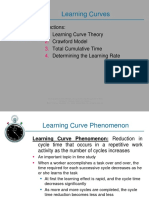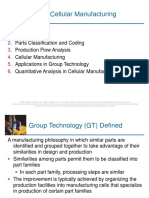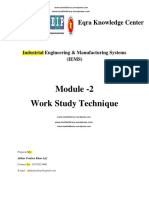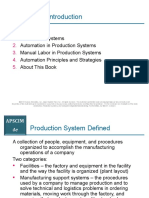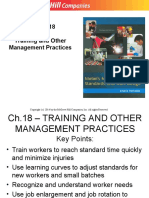0 ratings0% found this document useful (0 votes)
114 viewsNotes Ch19-Learning Curves
Uploaded by
ASAD ULLAHCopyright
© © All Rights Reserved
Available Formats
Download as PPT, PDF, TXT or read online on Scribd
0 ratings0% found this document useful (0 votes)
114 viewsNotes Ch19-Learning Curves
Uploaded by
ASAD ULLAHCopyright
© © All Rights Reserved
Available Formats
Download as PPT, PDF, TXT or read online on Scribd
You are on page 1/ 27
Learning Curves
Sections:
1. Learning Curve Theory
Chapter 19
2. Why the Learning Curve Occurs
3. Determining the Learning Rate
4. Factors Affecting the Learning Curve
5. Learning Curve Applications
6. Time Standards Versus the Learning
Curve
Work Systems and the Methods, Measurement, and Management of Work
by Mikell P. Groover, ISBN 0-13-140650-7.
©2007 Pearson Education, Inc., Upper Saddle River, NJ. All rights reserved.
Learning Curve Phenomenon
Reduction in cycle time that occurs in a repetitive
work activity as the number of cycles increases
An important topic in time study
When a worker accomplishes a task over and
over, the time required for each successive
cycle decreases as he or she learns the task
At first the learning effect is rapid, and the
cycle time decreases significantly
As more and more cycles are completed,
the cycle time reduction becomes less and
less
Work Systems and the Methods, Measurement, and Management of Work
by Mikell P. Groover, ISBN 0-13-140650-7.
©2007 Pearson Education, Inc., Upper Saddle River, NJ. All rights reserved.
Learning Curve Theory
According to theory, there is a constant learning
rate that applies to a given repetitive task
Learning rate = the proportion by which the
dependent variable (e.g., task time) is multiplied
every time the number of task cycles doubles
Example: If T1 = 10 hr and LR = 80%, then
T2 = 0.80(10) = 8.0 hr,
T4 = 0.80(8.0) = 6.4 hr
T8 = 0.80(6.4) = 5.12 hr
and so on
Work Systems and the Methods, Measurement, and Management of Work
by Mikell P. Groover, ISBN 0-13-140650-7.
©2007 Pearson Education, Inc., Upper Saddle River, NJ. All rights reserved.
Learning Curve for LR = 80%
Work Systems and the Methods, Measurement, and Management of Work
by Mikell P. Groover, ISBN 0-13-140650-7.
©2007 Pearson Education, Inc., Upper Saddle River, NJ. All rights reserved.
Log-Linear Model
When learning curve time data are plotted on
log-log coordinates, the plot yields a straight
line with slope m
y = kxm
where y = dependent variable, k = constant
representing the value of the dependent
variable for the first work cycle, x = number of
work units completed, and m = slope
ln LR
m= and LR = 2m
ln 2
Work Systems and the Methods, Measurement, and Management of Work
by Mikell P. Groover, ISBN 0-13-140650-7.
©2007 Pearson Education, Inc., Upper Saddle River, NJ. All rights reserved.
Same Learning Curve in Log-Log Plot
Work Systems and the Methods, Measurement, and Management of Work
by Mikell P. Groover, ISBN 0-13-140650-7.
©2007 Pearson Education, Inc., Upper Saddle River, NJ. All rights reserved.
Two Widely Used Log-Linear Models
1. Crawford Model
Dependent variable is unit time TN
2. Wright Model
Dependent variable is cumulative
average time T N
Work Systems and the Methods, Measurement, and Management of Work
by Mikell P. Groover, ISBN 0-13-140650-7.
©2007 Pearson Education, Inc., Upper Saddle River, NJ. All rights reserved.
Crawford Model
Most widely used learning curve model in
industry today
TN T1N m
Example: T1 = 10 hr, LR = 80%, how long will
it take to complete the 20th work unit?
m = ln(0.80)/ln 2 = -0.32193
T20 = 10(20)-0.32193 = 3.81 hr
Work Systems and the Methods, Measurement, and Management of Work
by Mikell P. Groover, ISBN 0-13-140650-7.
©2007 Pearson Education, Inc., Upper Saddle River, NJ. All rights reserved.
Crawford Model
Total cumulative time
N
TTN T1 i m
i 1
Cumulative average time
TTN
TN
N
Work Systems and the Methods, Measurement, and Management of Work
by Mikell P. Groover, ISBN 0-13-140650-7.
©2007 Pearson Education, Inc., Upper Saddle River, NJ. All rights reserved.
Wright Model
First learning curve model to be published
Based on cumulative average time per unit
T N = T1Nm
Total cumulative time:
TTN = N T N
or TTN = T1Nm+1
Unit time:
TN = TTN - TTN-1
Work Systems and the Methods, Measurement, and Management of Work
by Mikell P. Groover, ISBN 0-13-140650-7.
©2007 Pearson Education, Inc., Upper Saddle River, NJ. All rights reserved.
Advantage of Log-Linear Model
Consists of only two parameters:
1. The time associated with the first unit
2. The slope m, from which can be derived the
learning rate LR
Conversely, if LR is known, the slope m
can be deduced
Work Systems and the Methods, Measurement, and Management of Work
by Mikell P. Groover, ISBN 0-13-140650-7.
©2007 Pearson Education, Inc., Upper Saddle River, NJ. All rights reserved.
Comparison of Crawford and Wright
Work Systems and the Methods, Measurement, and Management of Work
by Mikell P. Groover, ISBN 0-13-140650-7.
©2007 Pearson Education, Inc., Upper Saddle River, NJ. All rights reserved.
Why the Learning Curve Occurs
Contributions of the worker
Worker becomes familiar with the task - the
worker learns the task
Worker makes fewer mistakes as the task is
repeated
Hand and body motions become more efficient,
and there is a rhythm and pattern developed
Minor adjustments in workplace layout to
reduce distances
Fewer delays that interrupt the operation
Work Systems and the Methods, Measurement, and Management of Work
by Mikell P. Groover, ISBN 0-13-140650-7.
©2007 Pearson Education, Inc., Upper Saddle River, NJ. All rights reserved.
Why the Learning Curve Occurs
Contributions of the larger organization
Methods improvements by the IE Department
Fine-tuning of machinery and tooling
Development of special tooling
Technological improvements
Product design improvements
Improved quality of starting materials
Better scheduling
Improved logistical support
Better motivation of workers
Work Systems and the Methods, Measurement, and Management of Work
by Mikell P. Groover, ISBN 0-13-140650-7.
©2007 Pearson Education, Inc., Upper Saddle River, NJ. All rights reserved.
Contributions to the Learning Curve
Contributions to
learning by the
worker and the
organization
Work Systems and the Methods, Measurement, and Management of Work
by Mikell P. Groover, ISBN 0-13-140650-7.
©2007 Pearson Education, Inc., Upper Saddle River, NJ. All rights reserved.
Typical Learning Rates (Crawford)
Type of work LR, % Industry LR, %
Assembly 84-85 Aerospace 85
Prototype assembly 65 Complex machines 75-85
Clerical ops 75-85 Construction 70-90
Inspection 86 Electronics mfg 90-95
Machining 90 Machine shop 90-95
Welding 85-90 Shipbuilding 80-85
Work Systems and the Methods, Measurement, and Management of Work
by Mikell P. Groover, ISBN 0-13-140650-7.
©2007 Pearson Education, Inc., Upper Saddle River, NJ. All rights reserved.
Worker-Machine Systems
Learning in a work-machine system will be a
composite of the learning rates of the two
components of the system
LRw-m = pw LRw + pm LRm
where pw = proportion of cycle time controlled
by worker, and pm = proportion of cycle time
controlled by machine
Work Systems and the Methods, Measurement, and Management of Work
by Mikell P. Groover, ISBN 0-13-140650-7.
©2007 Pearson Education, Inc., Upper Saddle River, NJ. All rights reserved.
Interruptions in the Learning Curve
Learning curve effect tends to be disrupted by
interruptions in production
Possible reasons for interruptions:
Batch production, in which there are
extended periods between repeat orders
Labor strikes
Vacations
Raw material shortages
Work Systems and the Methods, Measurement, and Management of Work
by Mikell P. Groover, ISBN 0-13-140650-7.
©2007 Pearson Education, Inc., Upper Saddle River, NJ. All rights reserved.
Learning Loss due to Interruption
Work Systems and the Methods, Measurement, and Management of Work
by Mikell P. Groover, ISBN 0-13-140650-7.
©2007 Pearson Education, Inc., Upper Saddle River, NJ. All rights reserved.
Other Factors Affecting Learning
Product complexity
More opportunities for learning - higher T1
and lower LR
Preproduction planning
Fewer opportunities for learning - lower T1
and higher LR
Labor turnover - slower learning (higher LR)
Plateau model - learning curve consists of two
phases:
1. Start-up - log-linear model applies
2. Steady state - no further improvement
Work Systems and the Methods, Measurement, and Management of Work
by Mikell P. Groover, ISBN 0-13-140650-7.
©2007 Pearson Education, Inc., Upper Saddle River, NJ. All rights reserved.
Plateau Learning Curve Model
Work Systems and the Methods, Measurement, and Management of Work
by Mikell P. Groover, ISBN 0-13-140650-7.
©2007 Pearson Education, Inc., Upper Saddle River, NJ. All rights reserved.
Why the Plateau Model Occurs
In a worker-machine system, worker is finally
limited by the speed of the machine
No incentives for workers to make further
improvements
Management is unwilling or unable to invest in
newer production technologies that would
sustain the learning curve
Management does not believe that learning
can continue indefinitely, and this becomes a
self-fulfilling prophecy
Work Systems and the Methods, Measurement, and Management of Work
by Mikell P. Groover, ISBN 0-13-140650-7.
©2007 Pearson Education, Inc., Upper Saddle River, NJ. All rights reserved.
Learning Curve Applications
Accident prevention Pricing negotiations
Capacity planning Pricing strategies
Cost accounting Product design changes
Cost estimating Productivity analysis
Cost reduction Quality control
Contract administration Reliability analysis
Failure analysis Safety
Labor requirements Vendor selection
estimation Wage incentives
Make-or-buy decisions Warranty maintenance
Methods analysis Worker performance
New product introduction analysis
Work Systems and the Methods, Measurement, and Management of Work
by Mikell P. Groover, ISBN 0-13-140650-7.
©2007 Pearson Education, Inc., Upper Saddle River, NJ. All rights reserved.
Time Standards vs. Learning Curve
Apparent contradiction:
A time standard is a constant value that is
defined under the following conditions:
Standard method
Standard work units
Performed by a trained average worker
Task is performed at 100% performance
But the learning curve predicts that the
actual time for the work cycle will decrease
over time
Work Systems and the Methods, Measurement, and Management of Work
by Mikell P. Groover, ISBN 0-13-140650-7.
©2007 Pearson Education, Inc., Upper Saddle River, NJ. All rights reserved.
How to Reconcile the Contradiction
Although the standard time is a constant, the
actual cycle time for a manual task is a variable
The time varies from one cycle to the next
One of the reasons why the cycle time varies is
because the worker learns the task
The cycle time is gradually reduced as the
number of repetitions increases, as predicted
by learning curve theory
As long as there are no changes in methods or
work unit, it seems fair to give credit to the
worker for reductions in cycle time due to
improvements in skill, effort, pace, etc.
Work Systems and the Methods, Measurement, and Management of Work
by Mikell P. Groover, ISBN 0-13-140650-7.
©2007 Pearson Education, Inc., Upper Saddle River, NJ. All rights reserved.
Standard Reference Quantity (SRQ)
In batch production, it can be argued that the
quantity of the production run should influence
the value of the time standard
Surely a worker must be given an
opportunity to learn a task before he or she
is measured against the time standard
SRQ = the discrete quantity of production (e.g.,
10, 100, 1000 units) for which the standard
time for the task is applicable
If the actual quantity of production is
different from the SRQ, then an adjustment
in the time standard is appropriate
Work Systems and the Methods, Measurement, and Management of Work
by Mikell P. Groover, ISBN 0-13-140650-7.
©2007 Pearson Education, Inc., Upper Saddle River, NJ. All rights reserved.
SRQ Adjustment Ratio
Work Systems and the Methods, Measurement, and Management of Work
by Mikell P. Groover, ISBN 0-13-140650-7.
©2007 Pearson Education, Inc., Upper Saddle River, NJ. All rights reserved.
You might also like
- Perkins 1103 and 1104c Engines Systems Operation Testing and Adjusting97% (35)Perkins 1103 and 1104c Engines Systems Operation Testing and Adjusting56 pages
- Chapter 3 Manufacturing Metrics and EconomicsNo ratings yetChapter 3 Manufacturing Metrics and Economics15 pages
- Sections: The Nature of Work Defining Work Systems Types of Occupations Productivity Organization of The BookNo ratings yetSections: The Nature of Work Defining Work Systems Types of Occupations Productivity Organization of The Book36 pages
- SOLUTION-Introduction To Modern Power Electronics33% (3)SOLUTION-Introduction To Modern Power Electronics37 pages
- CH 18 Transfer Lines and Similar Automated Manufacturing SystemsNo ratings yetCH 18 Transfer Lines and Similar Automated Manufacturing Systems28 pages
- Sand Casting: Automation, Production Systems, and Computer-Integrated Manufacturing, Third Edition, by Mikell P. GrooverNo ratings yetSand Casting: Automation, Production Systems, and Computer-Integrated Manufacturing, Third Edition, by Mikell P. Groover38 pages
- Chapter 10 - Work Measurements and StandardsNo ratings yetChapter 10 - Work Measurements and Standards72 pages
- Solutions Manual: Ch29-Job Evaluation-S: Review QuestionsNo ratings yetSolutions Manual: Ch29-Job Evaluation-S: Review Questions2 pages
- Types of Assembly Lines:: 1.single Model Line 2.batch Model Line 3.mixed Model LineNo ratings yetTypes of Assembly Lines:: 1.single Model Line 2.batch Model Line 3.mixed Model Line10 pages
- Learning Curves-Technology and Operations ManagementNo ratings yetLearning Curves-Technology and Operations Management23 pages
- The Role of Ergonomics For Construction Industry Safety and Health ImprovementsNo ratings yetThe Role of Ergonomics For Construction Industry Safety and Health Improvements5 pages
- Join Us On Whatsapp For Daily Newspapers and PDF Books Etc #0344-3310224No ratings yetJoin Us On Whatsapp For Daily Newspapers and PDF Books Etc #0344-33102246 pages
- Dawn Editorials and Opinions 18th MarchNo ratings yetDawn Editorials and Opinions 18th March23 pages
- Reinforced Concrete Continuous Beam Analysis and Design (CSA A23.3-14)No ratings yetReinforced Concrete Continuous Beam Analysis and Design (CSA A23.3-14)44 pages
- Ohio 7100 Operating Table - Service ManualNo ratings yetOhio 7100 Operating Table - Service Manual253 pages
- Cubic Foot Weight of Crushed Bituminous Coal: Standard Test Method ForNo ratings yetCubic Foot Weight of Crushed Bituminous Coal: Standard Test Method For4 pages
- Easa Airworthiness Directive: AD No.: 2011-0197No ratings yetEasa Airworthiness Directive: AD No.: 2011-01973 pages
- Roy and Diana Vagelos Education Center: Columbia University Medical Center, New York, NYNo ratings yetRoy and Diana Vagelos Education Center: Columbia University Medical Center, New York, NY20 pages
- 193504905-LTE-Optimization Question and Answer For Interview100% (1)193504905-LTE-Optimization Question and Answer For Interview18 pages
- Equipment Installation, Servicing, On-Site Support SOPNo ratings yetEquipment Installation, Servicing, On-Site Support SOP3 pages
- Flexural Design of Prestressed Beams Using Elastic Stresses ExampleNo ratings yetFlexural Design of Prestressed Beams Using Elastic Stresses Example5 pages
- Fracture Toughness Properties of High-StrengthNo ratings yetFracture Toughness Properties of High-Strength10 pages
- Perkins 1103 and 1104c Engines Systems Operation Testing and AdjustingPerkins 1103 and 1104c Engines Systems Operation Testing and Adjusting
- Sections: The Nature of Work Defining Work Systems Types of Occupations Productivity Organization of The BookSections: The Nature of Work Defining Work Systems Types of Occupations Productivity Organization of The Book
- CH 18 Transfer Lines and Similar Automated Manufacturing SystemsCH 18 Transfer Lines and Similar Automated Manufacturing Systems
- Sand Casting: Automation, Production Systems, and Computer-Integrated Manufacturing, Third Edition, by Mikell P. GrooverSand Casting: Automation, Production Systems, and Computer-Integrated Manufacturing, Third Edition, by Mikell P. Groover
- Solutions Manual: Ch29-Job Evaluation-S: Review QuestionsSolutions Manual: Ch29-Job Evaluation-S: Review Questions
- Types of Assembly Lines:: 1.single Model Line 2.batch Model Line 3.mixed Model LineTypes of Assembly Lines:: 1.single Model Line 2.batch Model Line 3.mixed Model Line
- Learning Curves-Technology and Operations ManagementLearning Curves-Technology and Operations Management
- Practical Guide To Work Study [Revised Edition]From EverandPractical Guide To Work Study [Revised Edition]
- The Role of Ergonomics For Construction Industry Safety and Health ImprovementsThe Role of Ergonomics For Construction Industry Safety and Health Improvements
- Join Us On Whatsapp For Daily Newspapers and PDF Books Etc #0344-3310224Join Us On Whatsapp For Daily Newspapers and PDF Books Etc #0344-3310224
- Reinforced Concrete Continuous Beam Analysis and Design (CSA A23.3-14)Reinforced Concrete Continuous Beam Analysis and Design (CSA A23.3-14)
- Cubic Foot Weight of Crushed Bituminous Coal: Standard Test Method ForCubic Foot Weight of Crushed Bituminous Coal: Standard Test Method For
- Roy and Diana Vagelos Education Center: Columbia University Medical Center, New York, NYRoy and Diana Vagelos Education Center: Columbia University Medical Center, New York, NY
- 193504905-LTE-Optimization Question and Answer For Interview193504905-LTE-Optimization Question and Answer For Interview
- Equipment Installation, Servicing, On-Site Support SOPEquipment Installation, Servicing, On-Site Support SOP
- Flexural Design of Prestressed Beams Using Elastic Stresses ExampleFlexural Design of Prestressed Beams Using Elastic Stresses Example













